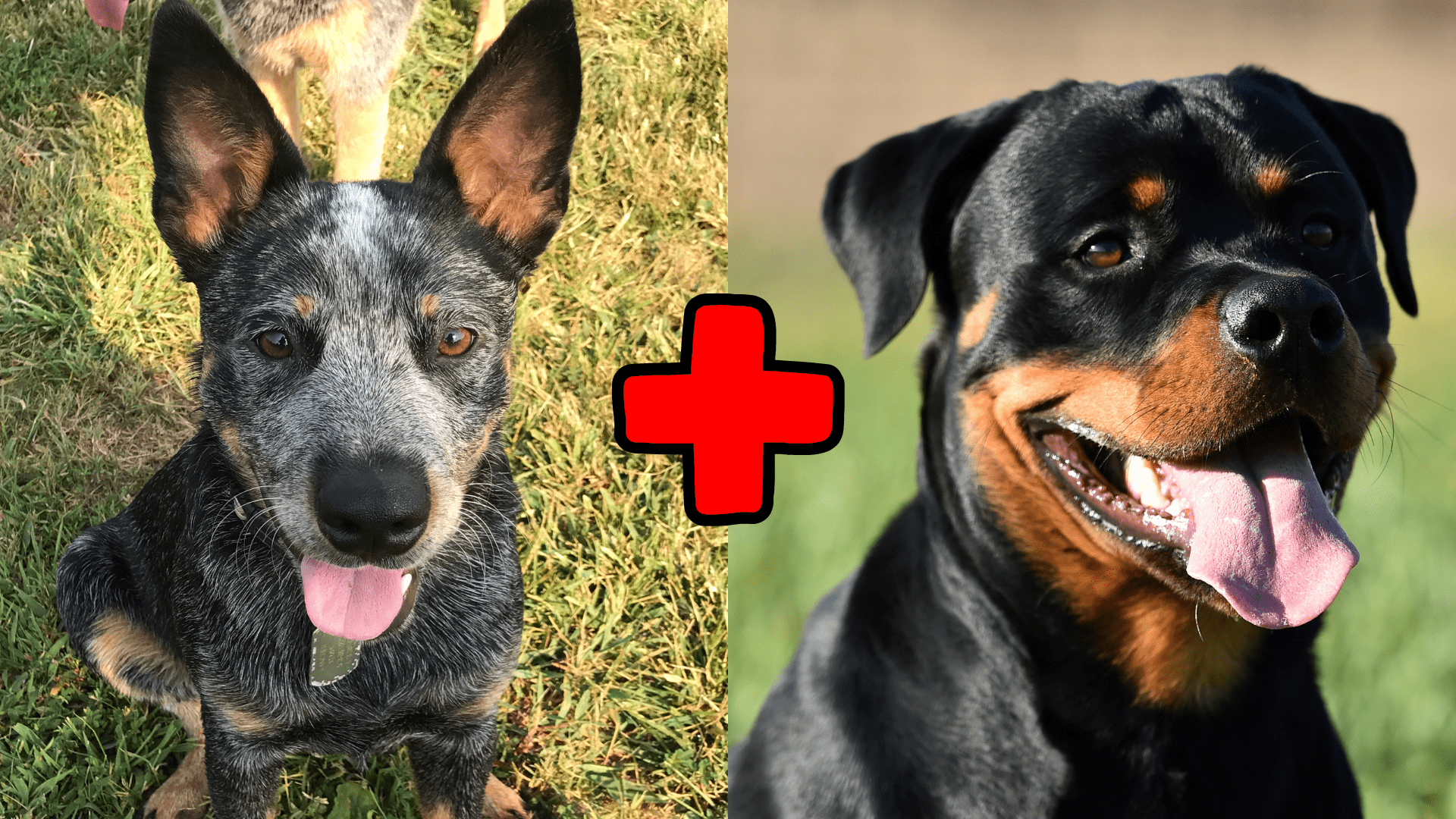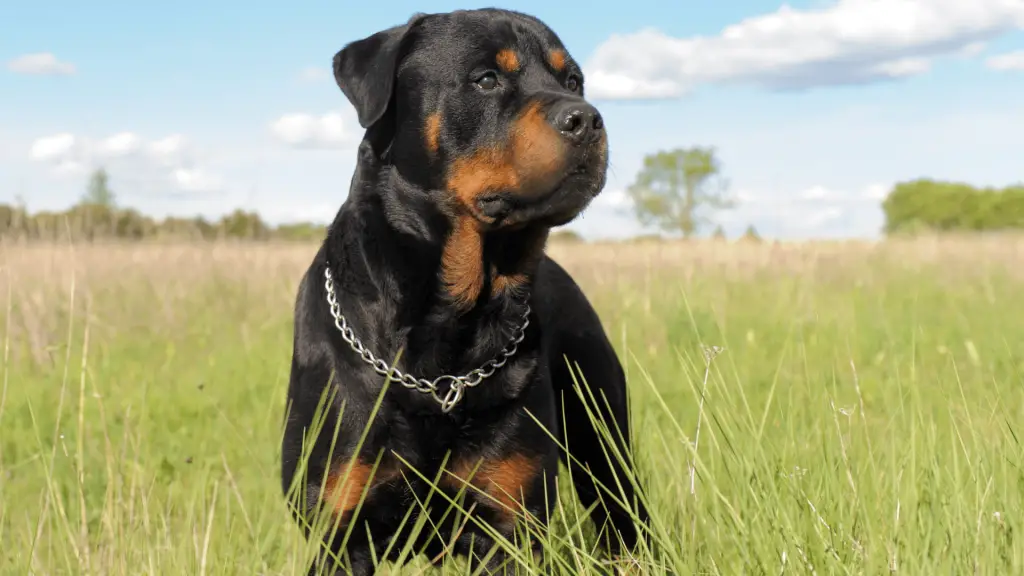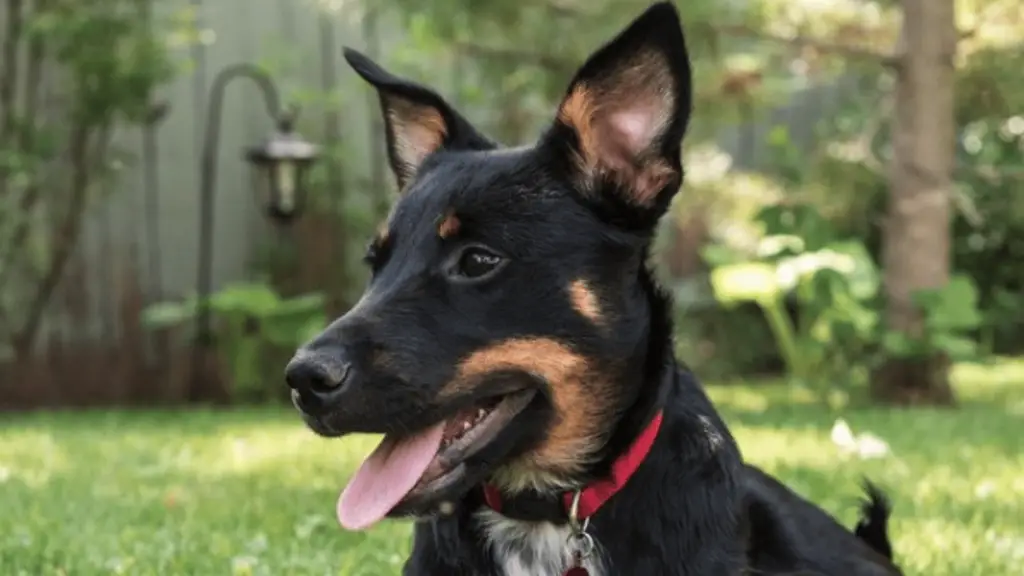Pawscessories is reader-supported. When you buy via links on our site, we may earn an affiliate commission at no cost to you.
Learn more.
Suppose you’re looking for a loyal, intelligent, hardworking dog that is good with children. In that case, the blue heeler rottweiler mix may be the perfect breed for you!
This hybrid dog is a cross between the Australian cattle dog and the Rottweiler and has all the best qualities of both breeds.
In this article, we will cover everything you need to know about the Blueweiler – from its history to its appearance and temperament – so you can make an informed decision if this is the right dog breed for you.
Table of Contents

What Is A Blueweiler?
The Blueweiler is a mix between the Australian Cattle Dog (also known as the Blue Heeler) and the Rottweiler.
While it’s unknown why this breed was created, it’s thought that the Blueweiler was bred for its loyalty, hardworking attitude, and protective nature.
The choice of the Rottweiler and Blue Heeler as parent breeds was likely due to their complementary temperaments and traits.
History Of The Rottweiler Blue Heeler Mix
Without a documented history, it can be hard to say definitively where mixed breeds come from. However, when we look at each parent breed’s history, we can better understand the Blueweiler’s history.
Rottweiler History

The Rottweiler is a long-standing breed that has been around since before Christianity. The Rottweiler was utilized for various purposes, including herding, guarding, and being a friend.
Though their true origins are unknown, it is believed that the Rottweiler breed is a descendant of the cattle-driving dogs. Roman legions used those dogs to herd cattle as they traversed through Germany during the 2nd century CE.
In the 19th century, the Rottweiler was introduced to America, where it became a popular working dog.
Today, Rottweilers can be used as working dogs or family dogs. They are known for being very protective of their family and can make great guard dogs.
Blue Heeler (Australian Cattle Dog) History

The Blue Heeler, also known as the Australian Cattle Dog or Queensland Blue Heeler, was created in the 1800s for herding cattle in Australia.
They originated when a cattle farmer named Thomas Hall from New South Wales crossbred two dogs used as drovers in Northumberland. They were thought to be smooth-coated collies being crossed with tamed dingoes. Resulting in the crossbreed that was named Halls Heelers.
Over time the Halls Heelers were developed into two breeds, the Australian Cattle Dog and the Australian Stumpy Cattle Dog.
The blue heeler is known for being clever, energetic, and loyal. They are easy to train but need more exercise than other dogs. Blue heelers work as farm or ranch dogs because of their herding nature. But they can also be great family pets.
Blue Heeler Rottweiler Mix Quick Summary
The Blue Heeler Rottweiler mix was likely bred to create a loyal, intelligent, energetic, hardworking, and protective dog.
This mixed breed makes an excellent companion for active families or individuals. This mixed breed is also likely to inherit the herding instincts of its parents. Therefore, this mixed breed would make an excellent working dog.
The mixed breed has many of the same characteristics as its parent breeds. Here are a few common features of the Blue Heeler X Rottweiler:
- Large and muscular build
- High prey drive
- Intelligent and eager to please
- Sort/Medium coat
- Moderate to heavy shedder
- Floppy ears or erect ears
- Gentle and loving personality
- Great family dog
- Loyal and protective
- Black, blue, red, white, and rust coloring
- Double coated
- From jowls
- High energy
- Low maintenance
Remember that each dog is unique and may not inherit all these characteristics. In addition, training and socialization will play a big role in your dog’s temperament.
Appearance & Build

Imagine a dog that looks like a Rottweiler but with the blue and white patches of the Australian Cattle Dog. That is what a Blueweiler looks like.
While the Rottweiler Blue Heeler mix can take on any traits from their parent breeds, they are typically large double-coated dogs with short to medium-length coats. In addition, their head is usually less blocky than a Rottweiler, and their ears can be either floppy or erect.
In addition, their muzzle is usually rounded and longer than a Rottweiler. Similar to the blue heelers. The Blueweilers have short coats that come in black, blue, red, white, and rust, with different combinations depending on what they inherit. They also tend to have dark brown or blue eyes.
A Blue Heeler Rottweiler usually has a mottled blue coat with black streaks. In addition, their ears are stiff, and their limbs are tan in color. However, you can also have a Black Heeler Rottweiler mix with a black coat with tan markings and blue and white streaks.
A Red Heeler, like a Blue Heeler, is a mottled red dog. When crossed with a Rottweiler, the puppies can have a black coat with red mottled markings on their chest and legs or a mottled red coat with black and rust-colored streaks.
Unfortunately, you can’t predict what a mixed-breed dog will look like since they might inherit more genes from one parent than the other.
Rottweiler Blue Heeler Mix Size (Weight & Height)
The full-grown Rottweiler blue heeler mix is a medium to large-sized dog. They typically weigh between 45 and 90 pounds and range from 18 to 25 inches tall at the shoulder. The males will be on the larger end of the spectrum, and the females on the smaller end.
Their size will highly depend on which parents they take after more. Here is a quick breakdown of the average size ranges for both parent breeds:
- Blue Heeler Height: 17 – 10 inches, weight: 35 – 50 pounds.
- Rottweiler Height: 22 – 27 inches, weight: 80 – 130 pounds.
So the Blue Heeler Rottie Mix can technically fall anywhere in these size ranges.
Rottweiler Blue Heeler Mix Shedding & Grooming

The Blueweiler is a moderate to heavy shedder. Therefore, they will require weekly brushing and grooming to help reduce the amount of hair shed around the house.
If they inherit the Blue Heeler coat, they will have less shedding than the Rottie coat. But if they get the Rottweiler coat, expect to do a lot of vacuuming, especially during the shedding seasons (fall and spring).
As for bathing, they will only need it when they are dirty or start to develop a doggy odor. Bathing them too often can strip the natural oils from their skin and coat, leading to other issues like dry skin.
Generally, they are considered low-maintenance dogs.
Here are some grooming tools you will require for this mixed breed:
- Nail clippers
- Dog toothbrush
- Soft bristle brush
- Doggy shampoo
- Ear cleaning solution
- Optional: dog blow dryer and teeth cleaning toy
Are Blueweilers Hypoallergenic?
The Blueweiler is not hypoallergenic. They are moderate shedders with dander (dead skin cells), which people with allergies are susceptible to.
Rottweiler Blue Heeler Mix Lifespan
The Blueweiler has a lifespan of 9 to 14 years. Their lifespan falls in the middle between their parent breeds. The Blue Heeler has a lifespan of 12 – 15 years, and the Rottweiler has a lifespan of 8 – 11 years.
With exercise, a proper diet, and preventive care, they can live long, happy, and healthy life.
Common Health Issue

The Blueweiler is a relatively healthy dog with an average lifespan. However, like all mixed breeds, they are prone to some health conditions that their parent breeds are susceptible to. Some of these health problems include:
Joint Issues
Hip & elbow dysplasia are common conditions where the hip or elbow joint doesn’t develop properly. It can cause pain, lameness, and arthritis later on in life.
Blue Heelers and Rottweilers are both prone to conditions affecting their joints. So expect their offspring to have similar risks of developing these conditions.
Allergies
Both parent breeds are prone to allergies. The Blueweiler can inherit these allergies from either parent and may be allergic to pollen, grass, dust mites, and other common allergens.
If your dog is constantly scratching, has runny eyes or nose, or generally seems uncomfortable, they may have allergies.
Eye Issues
Blue Heelers and Rottweilers are prone to eye issues. These include cataracts, glaucoma, and progressive retinal atrophy (PRA). So the Blueweiler will be susceptible to these as well.
Cataracts are a common condition that causes the eye’s lens to become cloudy. It can eventually lead to blindness if left untreated.
Glaucoma is a condition that increases pressure in the eye, which can damage the optic nerve and lead to blindness.
Progressive retinal atrophy (PRA) is a degenerative disease that causes the retina to slowly deteriorate, eventually leading to blindness.
Heart Problems
Like its parents, the Blue Heeler Rottweiler mix will also be prone to heart problems. These can include congenital heart defects, valve disease, and arrhythmias. Rottweilers are predisposed to heart disease.
Cancer
All dogs can get cancer; unfortunately, the Rottweiler is especially prone to this disease. So the blue heeler rottweiler mix will increase the risk of developing cancer.
Some common cancers affecting Rottweilers include bone cancer, lymphoma, and mast cell tumors. So the Rottweiler Australia shepherd mix will also be prone to certain forms of cancer.
This is why vet checks are necessary to maintain a dog’s health and prevent any issues.
Von Willebrand Disease
Von Willebrand disease is a bleeding disorder that Rottweilers are especially prone to. So the blue heeler rottweiler mix may also be affected by this disease. It is a disease that prevents the blood from clotting properly.
If your dog has von Willebrand disease, they may bleed excessively from even a small cut or injury. They may also have nosebleeds, blood in their stool, or heavy menstrual bleeding.
Blue Heeler Rottweiler Mix Trainability & Intelligence
The Blueweiler is an intelligent dog that is easy to train. They are eager to please their owners and love to have a job to do.
Both parent breeds are known for being intelligent and easy to train. The Blue Heeler is ranked 31st out of 138 on Stanley Coren’s Intelligence of Dogs list. The Rottweiler is ranked 12th out of 138. So this crossbreed would fall somewhere in the top 30 for intelligence.
The Blueweiler is a dog eager to please their owners and learn commands quickly. Blueweilers make great service dogs, therapy dogs, and obedience competitors. They excel at agility, flyball, tracking, and herding.
Further Readings: 9 Simple Steps To Create The Obedient Dog Of Your Dreams
Blue Heeler Rottweiler Mix Activity Level & Exercise Needs

The Blueweiler is a high-energy dog that needs a lot of exercise. They are the perfect dog for an active family or individual who enjoys outdoor activities.
They need frequent stimulation. This can be from long walks, runs, playing fetch, or frisbee. Without enough exercise, they can become destructive and develop bad habits.
They may dig holes, destroy furniture, bark excessively, and nip or chew on things without proper stimulation.
The Blueweiler is not the best dog for first-time dog owners or those that live a sedentary lifestyle. If you cannot provide them with the exercise they need, then this is not the right breed of dog for you.
They require a minimum of 75 minutes of exercise per day. They will love to go on long walks, runs, hikes, and playing fetch. It’s also a good idea to give them plenty of stimulating toys and puzzles to keep their minds occupied.
Blue Heeler Rottweiler Mix Temperament & Behavior
The temperament of a Blue Heeler Rottweiler mix is a combination of the Blue Heeler and the Rottweiler. These dogs are loyal, loving, and protective of their family. They are also obedient and easy to train.
However, they can also be aggressive towards other animals if not properly socialized from a young age. They are also very active and need a lot of exercise. Without enough exercise, they can become destructive.
To get a better idea of a Blue Heeler Rottweiler Mix temperament, here are the parent breeds’ temperaments:
The Blue Heeler
The Blue Heeler is a very loyal and loving dog. They are protective of their family and make great watchdogs. They are also very obedient and easy to train. However, they can be aggressive towards other animals if not properly socialized from a young age.
The Rottweiler
The Rottweiler is confident and calm. While they may be aloof with strangers, they’re devoted and loving to their families. They’re also protective, intelligent, and trainable but are not recommended for first-time owners.
Blue Heeler Rottweiler mixes are a combination of these traits. They make great family dogs and are loyal and loving. However, they need a lot of exercise and need to be properly socialized from a young age.
Suppose you’re looking for a high-energy affectionate dog that will protect your family. In that case, the Blueweiler might be the perfect breed for you!
Do Blueweilers Bark A Lot?
Rottweilers and Blue Heelers are known for being relatively quiet dogs. So Blueweilers tend not to bark a whole lot, either. However, they protect their home and family, so they may be cautious and bark to alarm you. Therefore, they have the qualities to make excellent guard dogs.
Do Blueweilers Like To Cuddle?
Every dog is a unique individual that may or may not like cuddles. Blueweilers are no different. For example, some Blueweilers may enjoy cuddles, while others may not be as fond of them. However, they are generally a loving and affectionate breed that enjoys spending time with their family.
Are Blueweilers Good With Kids?
Blueweilers are generally good with kids. They are a loyal and protective breed that will defend their family if they feel threatened. However, it’s important to socialize with them from a young age, so they know how to properly interact with other people and animals.
Are Blueweilers Good With Other Dogs?
Blueweilers can get along with other dogs if they are properly socialized from a young age. However, because of their herding instincts, they may try to herd other animals. They may also be aggressive towards other dogs if they feel threatened or protective of their family.
Are Blueweilers Good With Strangers?
Blueweilers can be aloof or even suspicious of strangers. They are a loyal and protective breed that will defend their family if they feel threatened. When socialized, they can learn to be friendly and accepting of new people.
Are Blueweilers Good Apartment Dogs?
No, Blueweilers are not good apartment dogs. While They are a very active breed that needs a lot of exercise. Without enough exercise, they can become destructive. If you live in an apartment, it’s important to ensure you can provide them with enough space to run and play.
Blue Heeler Rottweiler Mix Food & Diet
The Blueweiler is a medium to large-sized dog that needs a high-quality diet to maintain their health and energy levels. They need a diet high in protein and fat with moderate carbohydrates.
The Blueweiler is prone to obesity, so it’s essential to monitor their food intake and ensure they’re getting enough exercise. In addition, some Blueweilers may be allergic to certain ingredients, so it’s important to talk to your vet about what type of food is best for your dog.
Additionally, the food requirements of your dog will vary depending on his age, size, level of activity, and health. However, a dog needs 10-18% of their dog food should be protein, and 5.5-8% should be fat. Then roughly 50% from carbs, including 2.5-4.5% fiber. Each food brand you purchase will have specific feeding recommendations based on your dog’s age and size that you may follow.
The diet of a dog should be based on high-quality dry food. You may add wet or raw food or prepare your own meals, but this is the expensive route. High-quality dry food is all a dog needs to live a happy and healthy life.
Make sure you research to find the best dog food for them, ones that are balanced and nutritious.
Here are some top-tier food brands recommended by our veterinary consultant, Dr. Littlejohn:
Commercial Dry & Wet Food
Raw Food
Further Reading: 7 Simple Steps To Feeding Your Puppy (#4 Is Crucial)
What Is The Price Of A Rottweiler Blue Heeler Mix?
A purebred Rottweiler can cost anywhere from $1500 – $2500, whereas a Blue Heeler is between $500 – $1000.
So expect to pay between $500 to $1500 for a Blue Heeler Rottweiler mix puppy. But, of course, the price will depend on the breeder, where you live, the dog’s color, and other factors.
Where Can You Buy A Blue Heeler Rottweiler Mix Puppy?
Dog breeds like the blue heeler rottweiler mix can be challenging to find.
Your best bet is to purchase from a reputable online or local breeder.
Here are a couple options (just make sure to do your own research before buying):
I recommend against purchasing from a pet store as you cannot be sure of the dog’s quality or where it came from.
Local breeders may have Blue Heeler Rottweiler mix Puppies for sale, but they may not always have them, so you may have to wait for a litter to be born.
Where you live will also affect what breeders are available to you.
Pros and Cons of The Australian Cattle Dog Rottweiler Mix
Now that you know everything there is to know about the Blueweiler, it’s time to decide if this is the right breed for you. To help you make your decision, we’ve put together a list of pros and cons:
Cons Of Getting an Australian Cattle Dog Rottweiler Mix
- High prey drive.
- Can be territorial.
- High-energy dogs.
- Shedding.
- Can be a barker.
Pros Of Getting an Australian Cattle Dog Rottweiler Mix
- Low Maintenance.
- Great watchdogs.
- Loyal and protective of their family.
- Intelligent and easy to train with the proper motivation.
- Great guard dogs.
- Low maintenance grooming needs.
Final Thoughts
The Blueweiler is a loyal and protective breed that makes a great guard dog. In addition, they are intelligent and easy to train with the proper motivation.
However, they have high energy levels and require a lot of exercise. They also have a high prey drive and can be territorial. They are relatively low-maintenance breeds but require frequent stimulation and exercise, so they are not the best for sedentary families or individuals.
If you can provide them with the exercise, stimulation, and training they need, they make a great addition to any family.
Other posts you might find interesting:
Rottweiler Cocker Spaniel Mix (AKA The Cockweiler): Complete Guide
Great Dane Rottweiler Mix (AKA Weiler Dane): Breed Profile
Chihuahua Cattle Dog Mix (AKA The Chi Heeler): Breed Profile
